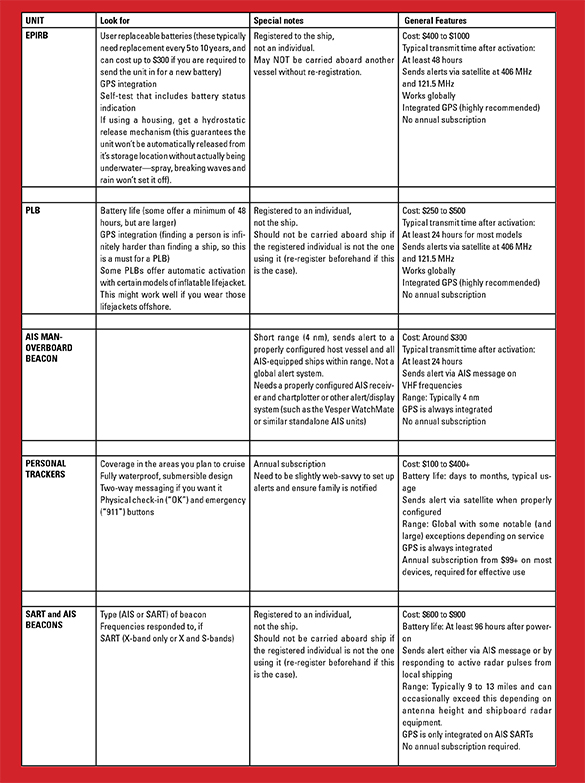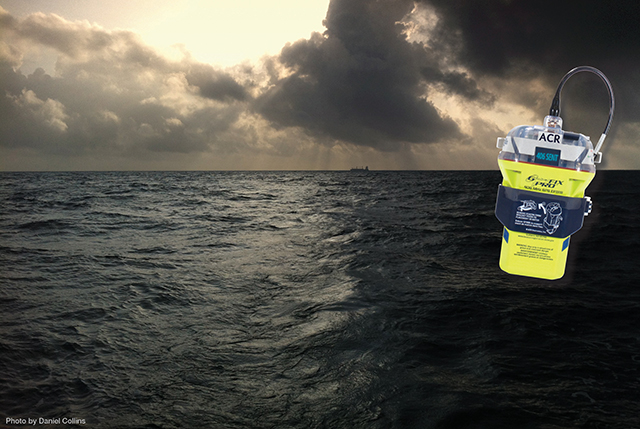What features make the newest safety gear right for you? (published May 2013)
Safety at sea is a concept that is impossible to wear out as each voyage has it’s own dangers, difficulties and unique risks. However, modern sailing practices and equipment have made offshore sailing radically safer than it used to be. Along with the well known EPIRB and SART, recent improvements in PLBs and the advent of advanced forms of DSC and AIS in VHF radios provide many more options for the savvy mariner to choose from.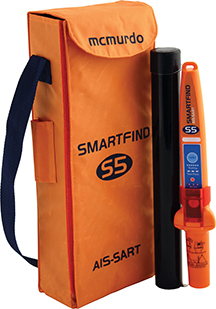
If the last sentence made your head spin, I’m sure walking into your local chandlery and taking a glance at all the safety electronics is enough to make you turn around and look at “Life is Good” t-shirts instead. This is the problem many of us have today: so many options, so many acronyms and so little differentiation. The good news is that all electronic safety gear is basically designed to do one thing—alert people who may be in a position to help you. The main differences between the various electronic safety options are: At what range and to whom these devices send a message, with what precision do they indicate your position, and how long after you turn them on will they keep working until you are rescued or the batteries run out.
Some of these devices add features like non-emergency alerts (letting people back home know you made it to a waypoint successfully, or need them to send that little care package you left before you headed out) and some even offer two-way communication. But the gist of their functionality is still the same—at their heart, they are all electronic safety devices. Let’s take a look at each major category of gear in turn.
EPIRB
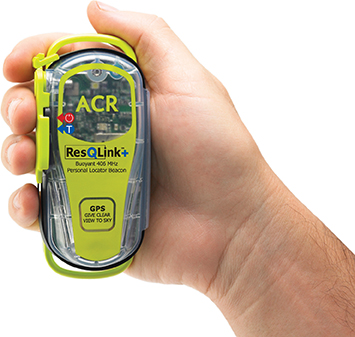 The granddaddy of all electronic safety devices is the Electronic Position-Indicating Radio Beacon (EPIRB). Designed for shipboard use, this device is specifically used to indicate distress of an entire vessel. EPIRBs now use an improved frequency of 406 MHz for alerts, replacing the old frequency of 121.5 MHz. However, they still send the 121.5 MHz signal for triangulation when ships get closer to your position. Modern EPIRBs can also offer GPS integration, which includes your nearly exact position in each alert. Without this accuracy, would-be assistance still has to search a large area of ocean to find your specific spot and this can be challenging to do, especially if you are reduced to a tiny liferaft instead of a larger vessel. So, if you’re going to buy a new one, it’s best to spend a small amount more to get an EPRIB with GPS integration.
The granddaddy of all electronic safety devices is the Electronic Position-Indicating Radio Beacon (EPIRB). Designed for shipboard use, this device is specifically used to indicate distress of an entire vessel. EPIRBs now use an improved frequency of 406 MHz for alerts, replacing the old frequency of 121.5 MHz. However, they still send the 121.5 MHz signal for triangulation when ships get closer to your position. Modern EPIRBs can also offer GPS integration, which includes your nearly exact position in each alert. Without this accuracy, would-be assistance still has to search a large area of ocean to find your specific spot and this can be challenging to do, especially if you are reduced to a tiny liferaft instead of a larger vessel. So, if you’re going to buy a new one, it’s best to spend a small amount more to get an EPRIB with GPS integration.
Many sailors store their EPIRB in a ditch bag, which is not a bad idea, but if you’re forced to abandon ship in a hurry or in adverse conditions, getting the ditch bag on deck can be difficult. EPIRB manufacturers offer special housings that are designed to allow the EPIRB to be stored above deck in a reasonably sheltered area (e.g. inside the cockpit, abaft the dodger). The EPIRB is then automatically released when the housing is flooded with water. Depending on your vessel and ditch bag access, you may want to consider this option.
PLB
The Personal Locator Beacon (PLB) is based on the EPIRB concept, alerting via satellite on the same frequencies. A much smaller device able to be worn on a lifejacket, the PLB is specifically designed to be registered and used by an individual, not a vessel, allowing you take it with you when you go aboard other ships without re-registration. Some couples on a budget have used PLBs in place of an EPIRB, sharing the registration between them. While this may work, it’s not how these are designed to operate. If you want to go this route, it’s probably best to check with your registration authority (NOAA in the U.S.).
It’s important to note that while a PLB is indeed a personal device, it is not able to directly notify the vessel in a man-overboard situation, as it uses only the EPIRB satellite and aircraft frequencies for alerting.
If you are aboard different boats frequently, cruise singlehanded or as a couple, are willing to accept the shorter battery life and want individual distress beacons as a redundant backup to the shipboard EPIRB, a PLB for each crewmember is a good choice in addition to, or occasionally as a replacement for, a vessel-dedicated EPIRB. Another good but slightly unofficial use for a PLB is to keep it in the dinghy or liferaft kit in case the ditch bag with the EPIRB doesn’t make it aboard.
AIS MAN-OVERBOARD BEACON
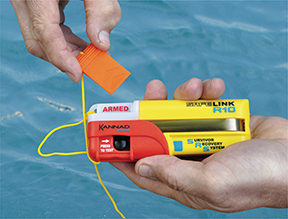 A relatively new entry in the market, the AIS Man-Overboard Alert Beacon is specifically designed as a short-range solution to notify a host vessel of a man-overboard (MOB). These can be a great help in a man-overboard situation, especially if you sail with a large crew and need individual accountability or are shorthanded and need the off-watch crewmembers to be alerted in the event of the on-watch crew going overboard.
A relatively new entry in the market, the AIS Man-Overboard Alert Beacon is specifically designed as a short-range solution to notify a host vessel of a man-overboard (MOB). These can be a great help in a man-overboard situation, especially if you sail with a large crew and need individual accountability or are shorthanded and need the off-watch crewmembers to be alerted in the event of the on-watch crew going overboard.
Often misidentified as an “AIS PLB”, these PLBs do NOT notify any authorities via satellite and are very short range (typically 4 nm in good conditions) requiring prompt action and notice onboard the host vessel. They have an onboard GPS receiver that sends an AIS alert over VHF radio frequencies indicating the exact (usually within a few feet) position of the device. With the right receiver and chartplotter this shows up with a screeching alarm and an icon on the chart showing the location of the MOB. The remaining crewmembers can then navigate to that position, even at night or in poor visibility. While not a replacement for sound and accurate seamanship, this certainly adds a layer of information that is helpful in a worst-case scenario.
PERSONAL TRACKERS
Made famous by the bright orange SPOT tracker and now available with a myriad of features from various manufacturers, the personal tracker is another fairly recent innovation in satellite-based safety. Like an EPIRB, it sends messages via satellite and has a near-global reach (although large portions of the lower Pacific and extreme polar areas are not covered), but unlike EPIRBs, it allows for non-emergency messages and tracking.
What does that mean? Simply put, you can update your friends and family without triggering an emergency. Personal trackers are helpful when they need peace of mind that you’re still OK and making progress, and it can be a fun record of your voyage to share on a blog or after the fact as a GPS track. Newer trackers are going far beyond simple “OK”, “Help”, and “911” messages though, and offer two-way messaging when used with a smartphone, much like text messages on cellular networks.
However, the main difference between these devices and EPIRBs/PLBs is that personal trackers use a private network of satellites, therefore requiring an annual subscription. Depending on the features you want, you’ll pay extra for such things as emergency services (which is presumably why you got the device in the first place), two-way messaging and various upgrades to the website your family and friends can track you on. This also leads to one serious point: if you haven’t set up your device’s services and subscriptions correctly on the manufacturer’s website, your emergency alerts won’t do anything!
While not a replacement for an EPIRB or PLB, these devices can be a handy backup and a fun way to let folks back home know you’re OK. With the two-way message plans you can even get some of the best features of satellite messaging at a lower cost. Just make sure you’ve kept the annual subscription up to date and that you’re within the coverage areas of the satellite network your device uses.
SART and AIS BEACONS
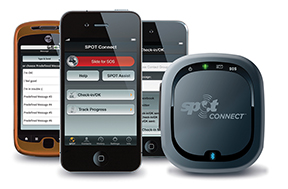 An under-appreciated item in any offshore sailor’s kit is the Search And Rescue Transponder (SART). Similar in function to an active radar reflector (itself a transponder), the SART responds to radar pulses sent from any ship running active radar in the area with a very noticeable pattern of strong return pulses that immediately notifies the operator of a vessel needing assistance in the area. Because the device uses active technology to respond to the radar pulse, it is perfect for liferafts and boats in distress, which usually do not send off a noticeable radar reflection on their own.
An under-appreciated item in any offshore sailor’s kit is the Search And Rescue Transponder (SART). Similar in function to an active radar reflector (itself a transponder), the SART responds to radar pulses sent from any ship running active radar in the area with a very noticeable pattern of strong return pulses that immediately notifies the operator of a vessel needing assistance in the area. Because the device uses active technology to respond to the radar pulse, it is perfect for liferafts and boats in distress, which usually do not send off a noticeable radar reflection on their own.
The SART exists on the principle that in most offshore emergency situations the first asset able to respond is the nearest cargo ship. Since there are many cargo ships in transit at any given time—all of which are required to carry radar—the SART can be a great help to assist in finding you.
However, the typical SART responds only to a certain frequency of radar called X-band, and more modern radars are often using another frequency called the S-band. SARTs that respond to both frequencies cost significantly more, but will be much more useful in an emergency.
Recently, AIS-equipped beacons, sometimes mis-marketed as “AIS SARTs”, have been introduced. More like a full-ship version of the AIS man-overboard beacon, and having a slightly lower theoretical range but working on proven VHF bands, AIS beacons broadcast a dedicated emergency message to all AIS-equipped vessels in the area. The AIS message is specifically designed to set off audible and visual alarms on the bridge of all equipped ships. While this is not of much use if there is no shipping within typical VHF range, it can be extremely useful to coordinate the final approach of help in poor visibility.
At this point it’s hard to say which version of the beacon is most likely to attract help: fishing vessels often have X-band radar but do not always have AIS, and modern shipping is required to have AIS but may be running a frequency of radar that your SART does not respond to or is inhibited by inclement weather. If you feel the need for an additional method for getting your Mayday out there, a SART or AIS beacon may make a good alternative method for attracting and coordinating help should it be needed.
OTHER HELPFUL TOOLS
In addition to these emergency-focused safety electronics, some of the most useful emergency equipment you have may already be onboard. Rugged waterproof satellite phones, your DSC-equipped SSB or VHF radio, and most AIS transponders (but not receivers) offer emergency alerting features. A satellite phone with GPS is particularly useful as it can be used to update assistance with needed information such as number of parties, weather conditions, and any injuries to prepare for. In addition, in an emergency situation that may not require rescue but just assistance (such as flooding but not sinking, or injuries that do not require airlift) a satellite phone or DSC distress signal can be the appropriate method of attracting attention without calling an effective Mayday. It’s also important to learn the use of the Pan-Pan radio call for these situations—meaning “we need help” but not “we need rescue” and is often the most appropriate request for non-disaster emergency situations.
A well-informed crew is a safer crew, so whatever gear you choose to equip your vessel with, ensure that all aboard know where it is, how to use it and under what circumstances it should and should NOT be used. Sail safely!